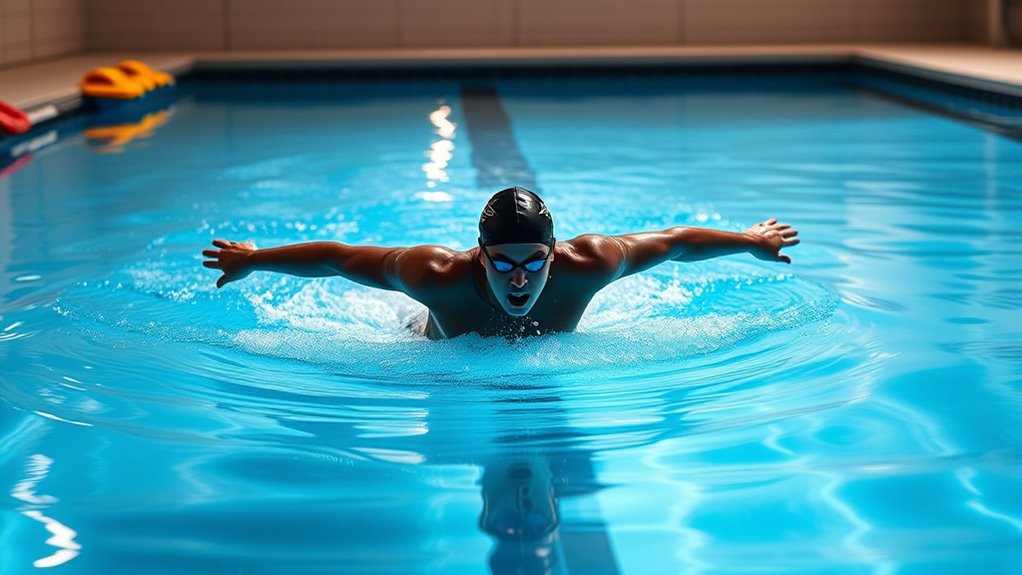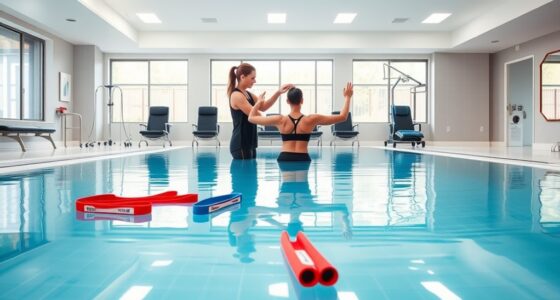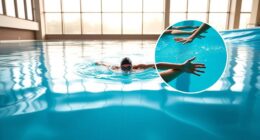To swim faster in your Endless Pool, focus on drills that improve your body position, streamline, and propulsion. Use streamlined body position practices, catch-up arm extension, fingertip drag for high elbows, and sculling to develop water feel. Incorporate kickboard drills, breath control exercises, reverse swimming, slow-motion strokes, and resistance band training. These techniques boost efficiency and power. Keep practicing these tools, and you’ll find even more tips to elevate your swim speed.
Key Takeaways
- Incorporate body position drills like streamlined body and water feel to reduce drag and improve efficiency in Endless Pools.
- Use kickboard and single-arm drills to enhance kicking rhythm, balance, and stroke power in a confined setting.
- Practice catch-up and fingertip drag drills to develop water awareness and smooth, effective arm movement.
- Implement resistance band exercises for strength training targeting propulsion and stability during pool workouts.
- Focus on tempo and rhythm drills, such as metronome pacing, to increase stroke rate and overall swimming speed.
Streamlined Body Position Drills
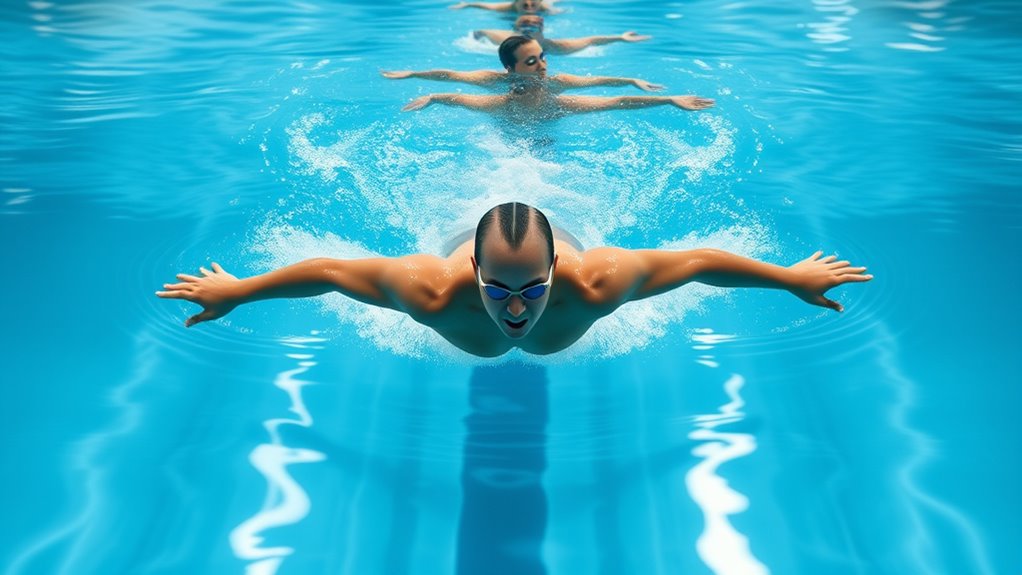
To swim faster, maintaining a streamlined body position is essential. You want your body to glide smoothly through the water with minimal resistance. Start by focusing on keeping your head aligned with your spine, looking straight down. Keep your hips high in the water to prevent drag and engage your core to stabilize your body. Practice body position drills by lying flat on your back or stomach and holding your breath, making sure your body stays straight and relaxed. Use fins or paddles to help feel the correct position and develop muscle memory. Regularly check your body’s alignment, and avoid excessive movement that can cause drag. Developing awareness of your water body position is crucial for efficiency. Perfecting your streamlined position will considerably improve your speed and efficiency in the water.
Catch-Up Drill for Arm Extension
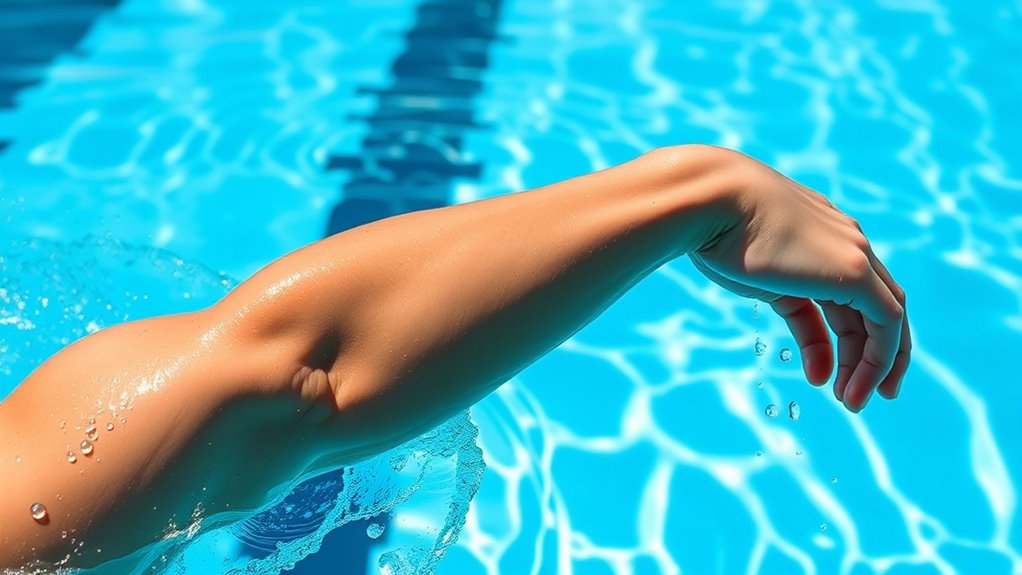
To improve your arm extension, focus on reaching fully forward with each stroke. Keep your body in a straight line to avoid unnecessary drag, and move smoothly from one arm to the other. Practicing these elements will help you swim more efficiently and faster. Incorporating proper technique drills enhances muscle memory and overall performance.
Emphasize Full Arm Reach
Focusing on full arm reach is essential for maximizing your efficiency and power in the water. When you extend your arm fully, you reduce drag and improve propulsion, making each stroke more effective. To visualize this, imagine your arm as a lever, reaching out to catch the water early. Think of the following imagery:
| Arm Extension Position | Water Engagement Point |
|---|---|
| Fully stretched forward | Water contact just before fingertips |
| Body aligned | Streamlined for minimal resistance |
| Smooth exit | Seamless passage to the next stroke |
Practicing this with the catch-up drill helps reinforce full extension. Focus on reaching out as far as possible before pulling back, ensuring your arm remains close to your body for maximum efficiency. Additionally, paying attention to body positioning can further enhance your glide and reduce drag during each stroke.
Maintain Body Line
Maintaining a proper body line is essential for maximizing your efficiency during the catch-up drill. Keep your body horizontal and aligned, minimizing drag as you swim. Focus on keeping your head in line with your spine, looking straight down, and engaging your core muscles. As you extend each arm forward, ensure your hips and legs stay close to the surface, avoiding unnecessary sinking or lifting. This streamlined position reduces resistance, allowing your arms to move smoothly through the water. Use controlled, deliberate movements to maintain your body’s position, especially during arm recovery and extension. Paying attention to your body positioning helps you develop better balance and coordination, making your strokes more efficient and helping you swim faster with less effort.
Practice Smooth Movement
Practicing smooth movement during the catch-up drill is key to developing a seamless arm extension. Focus on maintaining a steady, controlled rhythm as you reach forward with one arm, ensuring it fully extends before the other begins. Keep your movements deliberate, avoiding rushing through each stroke. This drill emphasizes the importance of a relaxed, fluid progression between arm movements, which helps improve your overall efficiency. Concentrate on keeping your body aligned and minimizing unnecessary movements. As you extend, feel the water grip and push back smoothly. When your hands meet at the front, pause briefly before starting the next stroke. Over time, this practice builds muscle memory for longer, more powerful arm extensions that translate into faster swimming. Incorporating mindfulness into your practice can enhance focus and body awareness, leading to better technique.
Fingertip Drag for High Elbow Recovery
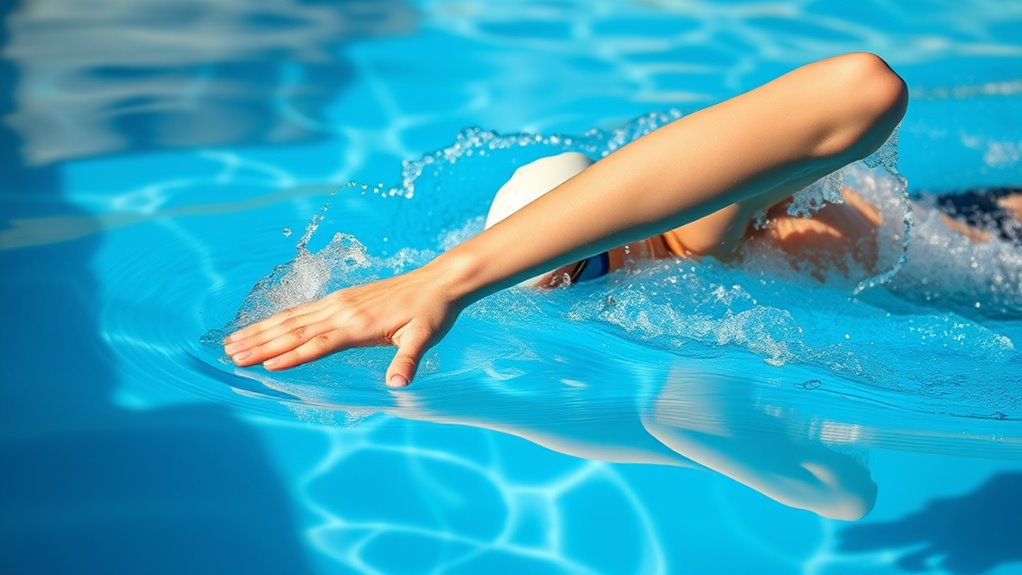
Have you ever wondered how to achieve a smoother, more efficient high elbow recovery? Fingertip drag is an excellent drill to help you do just that. By keeping your fingertips lightly on the water’s surface during recovery, you develop better control and feel for your arm movement. This technique encourages you to focus on lifting your elbow high and maintaining a relaxed, streamlined arm position. As you swing your arm forward, gently drag your fingertips along the water, which prevents overreaching or dropping your elbow. This drill also helps you develop a consistent rhythm and promotes a natural, relaxed recovery. Incorporating fingertip drag into your practice can also enhance your stroke efficiency and make your overall stroke more fluid and powerful.
Sculling for Feel and Control
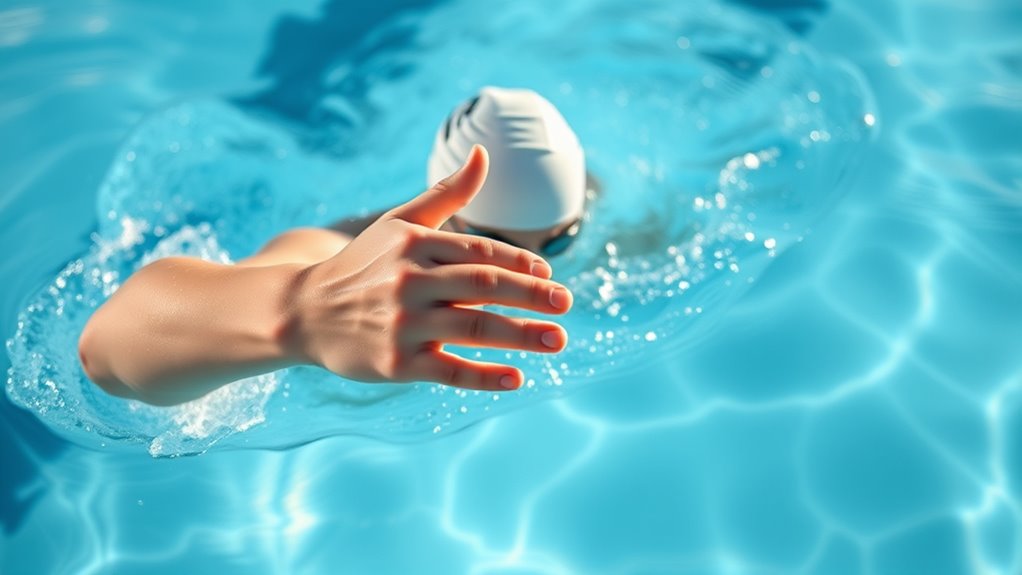
Ever wonder how to improve your feel for the water and gain better control over your movements? Sculling is a simple yet effective drill that helps you develop sensitivity and precision in the water. By focusing on small, controlled hand movements, you learn to gauge water resistance and adjust your stroke accordingly. To practice, keep your hands in front of you with palms facing slightly inward, moving them in a gentle figure-eight pattern. This motion emphasizes control over your water interaction, sharpening your sense of balance and timing. Regular sculling enhances your ability to feel the water’s flow, which translates to more efficient strokes and faster swimming. Incorporating sculling into your routine is a great way to refine your water interaction, making your overall swimming technique more effective. It’s a key drill for mastering water feel, giving you better control over every movement in the pool.
Kickboard Kick Technique Focus
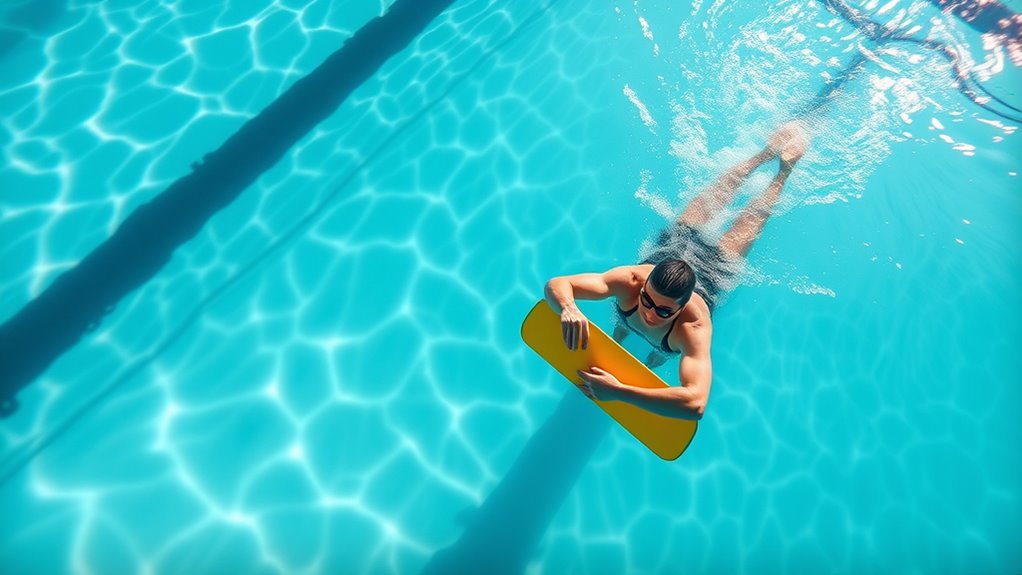
To improve your kickboard drills, focus on maintaining proper hand positioning to keep your body aligned. Keep a steady, consistent kicking rhythm to build efficiency and endurance. Paying attention to these points will help you develop a stronger, more effective kick. Incorporating regular practice with appropriate technique will accelerate your progress and improve your overall swimming performance.
Proper Hand Positioning
Proper hand positioning is essential for maximizing your kickboard drills and improving overall swimming efficiency. When holding the kickboard, keep your hands flat with palms facing down and fingers extended. Avoid gripping tightly, as this can cause tension and reduce streamline. Instead, lightly rest your hands on the board, maintaining a relaxed grip. Make sure your wrists stay in line with your forearms to promote a smooth, controlled kick. Proper hand placement helps you stay balanced and prevents unnecessary drag, allowing your legs to generate more power. Focus on keeping your elbows slightly bent and your hands steady throughout each kick. Good technique fundamentals are key to consistent improvement. Consistently practicing correct hand positioning will improve your kick technique, leading to more effective propulsion and faster swim times.
Consistent Kicking Rhythm
Maintaining a consistent kicking rhythm is key to improving your swim speed and efficiency. When your kicks are steady, your body stays balanced, reducing drag and conserving energy. Focus on finding a rhythm that feels natural and sustainable, rather than forcing fast, irregular kicks. Use a kickboard to isolate your legs and practice maintaining this rhythm without interruption. Count your kicks per stroke or set a metronome to keep a steady cadence. Over time, this consistency helps develop muscle memory, making your kicking more effortless and controlled. Remember, the goal isn’t speed alone, but smooth, efficient movement through the water. By mastering a reliable kicking rhythm, you’ll enhance your overall swim performance and endurance. Incorporating proper technique into your drills ensures that your efforts translate into better propulsion and reduced fatigue.
Single-Arm Swimming for Balance and Power
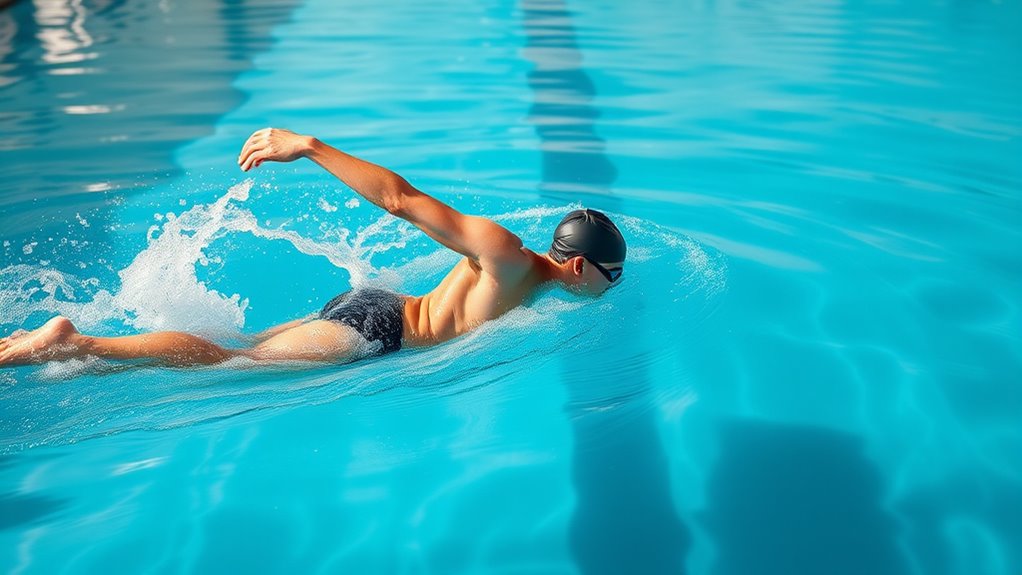
Single-arm swimming is an effective drill for building balance and increasing power in your stroke. It isolates each arm, helping you focus on maintaining proper body position and generating force efficiently. This drill also improves your awareness of arm movement, ensuring smoother, more controlled strokes. To visualize, here’s a breakdown:
| Focus Area | Benefits |
|---|---|
| Balance | Keeps hips aligned, reduces drag |
| Power | Develops stronger pull with each arm |
| Technique | Refines arm entry and exit angles |
| Breathing | Enhances breath control and timing |
| Body Position | Promotes streamlined posture |
Practicing single-arm drills regularly sharpens your stroke, making your entire swim more powerful and balanced.
Tempo Training to Improve Stroke Rate
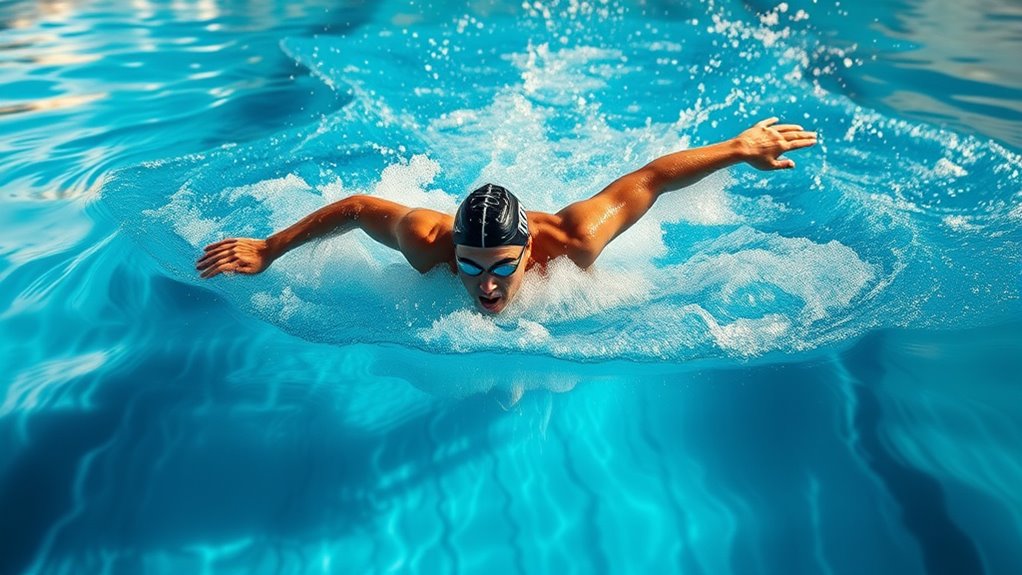
Tempo training is a powerful way to boost your stroke rate and efficiency in the water. By focusing on maintaining a consistent tempo, you train your muscles to move rhythmically, which helps develop a faster, more controlled stroke. Start by setting a metronome or using a swim watch to keep your tempo steady. Swim at a pace slightly faster than your usual, aiming to hit each stroke’s beat precisely. This method encourages you to shorten your stroke cycle without sacrificing technique. Over time, tempo training increases your turnover rate naturally, making you more agile and responsive in the water. It also helps you identify areas where you might be losing rhythm, giving you clear feedback to refine your stroke and swim faster with less effort.
Closed-Fist Drills to Enhance Feel for the Water
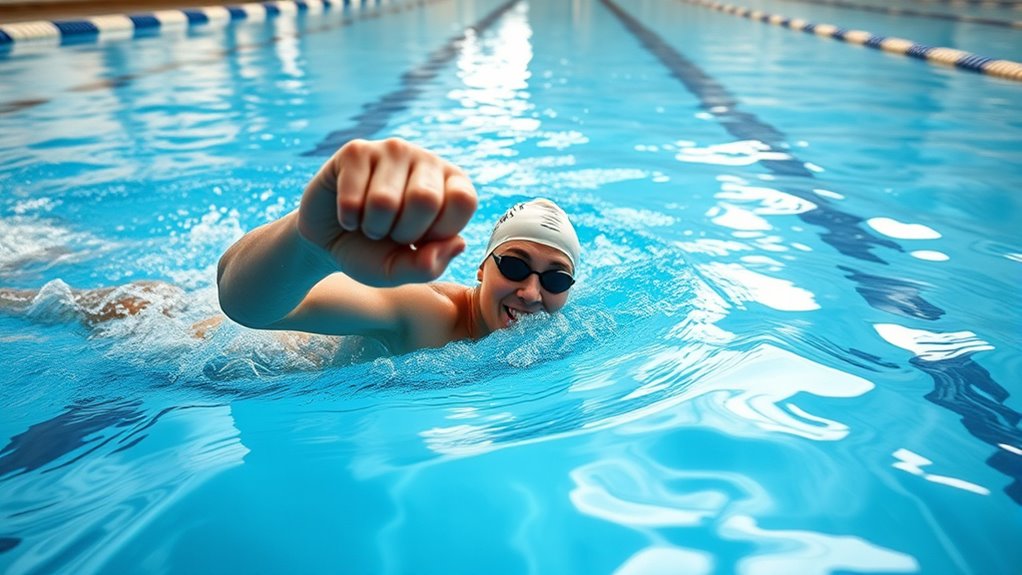
Closed-fist drills help you develop better hand sensitivity, allowing you to feel the water more effectively. They also strengthen your water connection and reinforce proper technique. Incorporating these drills can make a noticeable difference in your swim speed.
Improves Hand Sensitivity
Have you ever wondered how to develop a keener sense of water feel during your swim? Closed-fist drills are a simple yet effective way to boost hand sensitivity. They force you to rely more on your water sense, sharpening your awareness. During the drill, you focus on three key aspects:
- Feel for water resistance — Notice how your hand interacts with the water with a closed fist, helping you gauge water flow.
- Refining your catch — Develop better timing and positioning for a more efficient pull.
- Increasing proprioception — Improve your overall awareness of hand movement and position in the water.
Builds Water Connection
By focusing on how your hand interacts with the water through closed-fist drills, you deepen your connection with the water environment. Without the distraction of fingers, you concentrate on the larger surface of your palm and forearm, honing your awareness of water flow and pressure. This drill forces you to rely on your forearm and body positioning to generate propulsion, improving your overall feel. As you move through the water with a closed fist, you notice subtle changes in resistance and flow, helping you develop a better sense of how to manipulate water for maximum efficiency. This heightened awareness translates into smoother, more powerful strokes, ultimately making you more attuned to the water’s nuances during every swim.
Reinforces Proper Technique
Using closed-fist drills is an effective way to reinforce proper technique because they force you to focus on the essential aspects of water feel and body positioning. When you swim with fists clenched, you become more aware of your hand entry, arm extension, and body alignment. This heightened awareness helps develop a better sense of water resistance and control. To maximize the benefits, focus on:
- Maintaining a streamlined body position to reduce drag.
- Feeling the water’s texture and resistance with your forearms and elbows.
- Engaging core muscles to keep your hips elevated and balanced.
These drills challenge your awareness and help ingrain proper habits, making your swim more efficient and faster over time.
Breath Control and Rotation Exercises
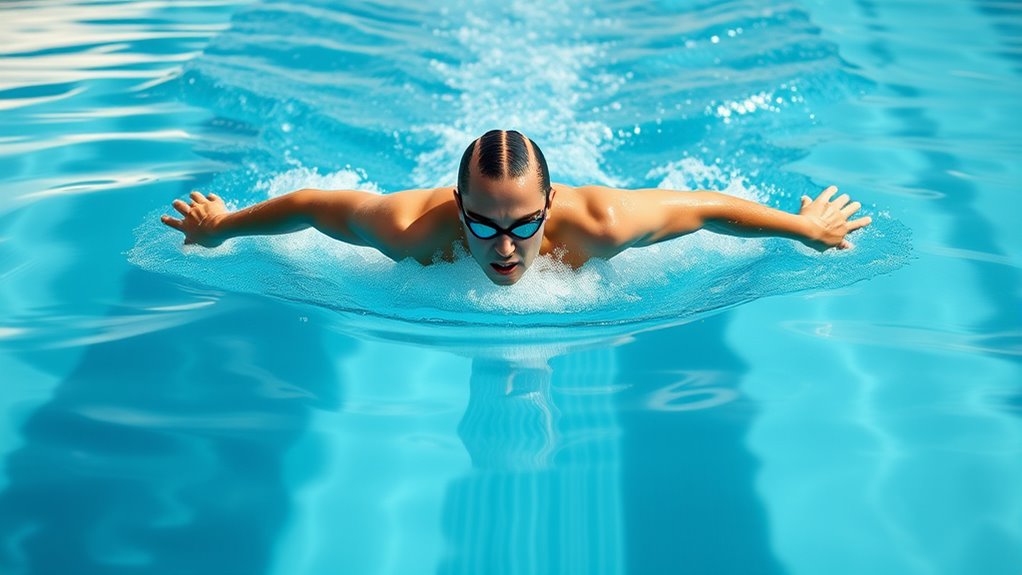
To swim efficiently and maintain stamina, mastering breath control and proper rotation is essential. These exercises help you stay relaxed and improve your overall technique. Practice rhythmic breathing, inhaling during one arm stroke and exhaling during the next, to develop consistency. Rotation exercises involve turning your torso smoothly with each stroke, reducing drag and increasing propulsion. Incorporate drills like side-breathing, one-arm swimming, and torso twists. Here’s a quick guide:
| Drill | Focus | Benefit |
|---|---|---|
| Side-breathing | Breath timing and balance | Better oxygen management |
| One-arm swim | Rotation and stroke efficiency | Improved body rotation |
| Torso twists | Core strength and flexibility | Enhanced rotation control |
| Rhythmic breathing | Consistent breath pattern | Increased stamina |
| Catch-up drill | Coordination and extension | Streamlined movement |
Consistent practice will help you breathe better and rotate smoothly, boosting your swim speed.
Reverse Swim for Underwater Efficiency
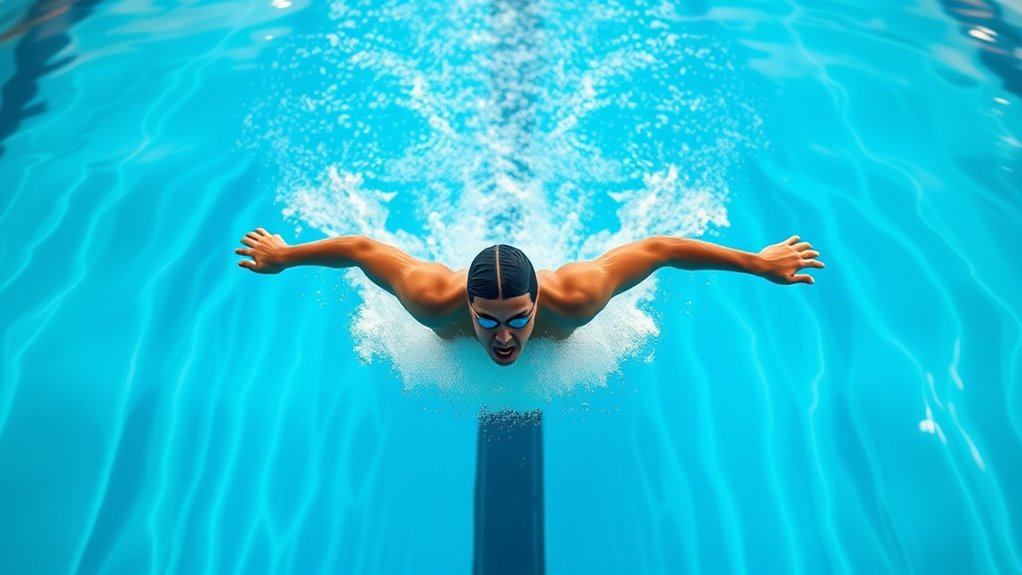
Building on your breath control and rotation exercises, incorporating reverse swimming can markedly boost your underwater efficiency. Reverse swims challenge your muscles to work differently, improving your propulsion and reducing drag. To maximize benefits:
Enhance your underwater efficiency by incorporating reverse swimming, focusing on streamlined form and controlled movements.
- Start with short distances to focus on maintaining streamlined form.
- Use a slow and controlled pace to emphasize smooth, efficient movements.
- Pay attention to your body position, ensuring your hips stay aligned and your core stays engaged.
Slow-Motion Stroke Practice
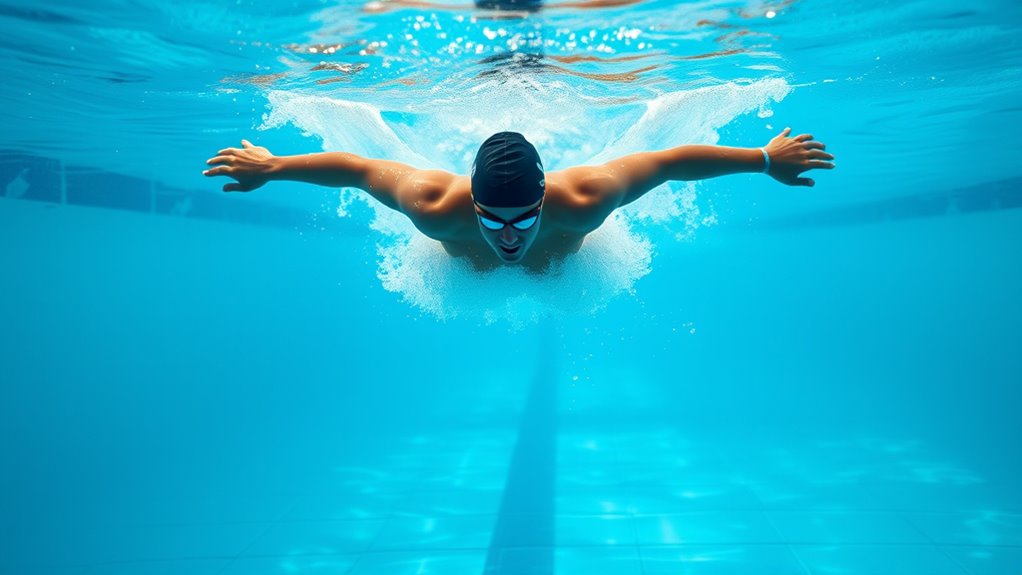
Practicing your stroke in slow motion allows you to focus intently on each movement, ensuring proper technique and muscle engagement. By slowing down, you can identify inefficient motions and correct subtle flaws that often go unnoticed at regular speed. Concentrate on maintaining a streamlined body position, smooth arm pulls, and precise breathing. This deliberate pace helps you develop muscle memory, making proper form instinctive during faster swims. Use the endless pool’s controls to gradually increase your stroke length and rhythm as you gain confidence. Slow-motion drills also improve your awareness of body alignment and coordination, which are essential for efficiency. Incorporate these sessions regularly to build a strong, refined technique that translates into faster, more effortless swimming.
Resistance Band Drills for Strength and Technique
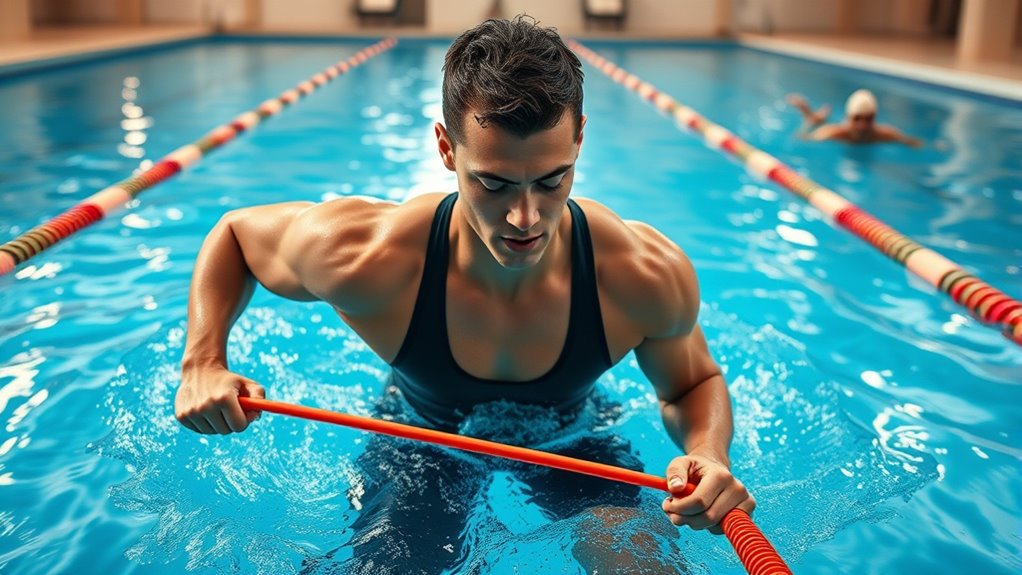
Resistance band drills are an effective way to boost your swimming strength and refine your technique. They help you focus on proper form while building muscle outside of pool time. To get started, choose a sturdy resistance band that suits your current strength level.
Here’s how to incorporate them:
- Attach the band to a secure point and perform pulling motions to enhance your back and arm strength.
- Use the band around your ankles during kick drills to improve leg propulsion and stability.
- Practice streamline drills with the band to develop core strength and body position.
Frequently Asked Questions
How Can I Integrate These Drills Into My Weekly Training Schedule?
You can integrate these drills into your weekly schedule by dedicating two to three sessions each week specifically for technique practice. Start with warm-ups, then focus on drills that target your weaknesses, and finish with cool-down laps. Mix in rest days for recovery, and gradually increase intensity. Consistency is key—by sticking to this plan, you’ll see improvements in your swim speed and efficiency over time.
Are These Drills Suitable for Beginner Swimmers or Only Advanced Athletes?
These drills are suitable for both beginners and advanced swimmers. As a beginner, you’ll find them helpful to develop proper technique and build confidence in the water. For advanced athletes, they refine your form and enhance speed. You can easily modify the drills to match your skill level, gradually increasing intensity. Incorporate them into your weekly routine to see steady improvement, regardless of your experience level.
What Common Mistakes Should I Watch Out for During These Drills?
You should watch out for overextending your arms, which can cause fatigue or poor form. Keep your movements smooth and controlled, avoiding rushing through drills. Maintain proper body position and focus on technique rather than speed. Many beginners tend to lift their heads or kick unevenly; stay relaxed and aligned. By paying attention to these common mistakes, you’ll improve faster and get the most benefit from your drills.
How Do I Measure Progress and Effectiveness of These Technique Drills?
You can measure your progress by tracking your time improvements and focusing on technique consistency. Use a waterproof stopwatch or the pool’s timing system to record your lap times regularly. Pay attention to your form—are you maintaining proper body position, streamlined movements, and efficient breathing? Recording videos of your drills helps you spot changes over time. Consistent effort and self-assessment will show your technique gains and overall swimming speed.
Can These Drills Help Improve My Open Water Swimming Performance?
Yes, these drills can definitely boost your open water swimming. They help refine your technique, increase efficiency, and build confidence in a controlled environment. By practicing proper body positioning, breathing, and stroke mechanics, you’ll transfer these skills to open water. Consistent training with these drills enhances your endurance and adaptability, making you a stronger, more confident open water swimmer ready to tackle any conditions.
Conclusion
Master these drills, and you’ll forge your path like a steady stream carving through stone. Each movement becomes a ripple that echoes through your swim, building momentum with every stroke. Embrace the rhythm, let your technique flow seamlessly, and watch as your speed accelerates like a current gaining strength. Keep practicing, stay focused—your journey toward faster swimming is a journey of continuous waves, shaping you into a force that moves effortlessly through the water.
